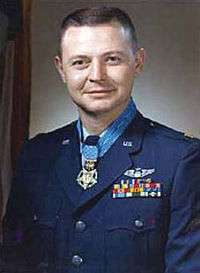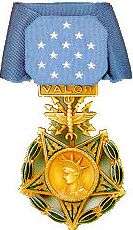Merlyn Hans Dethlefsen
| Merlyn Hans Dethlefsen | |
|---|---|
  Colonel Merlyn Dethlefsen | |
| Born |
June 29, 1934 Greenville, Iowa |
| Died | December 14, 1987 (aged 53) |
| Buried at | Arlington National Cemetery |
| Allegiance | United States of America |
| Service/branch |
|
| Years of service | 1953 - 1977 |
| Rank | Colonel |
| Unit | 333rd Fighter Squadron |
| Commands held | 96th Bombardment Wing |
| Battles/wars | Vietnam War |
| Awards |
Medal of Honor Distinguished Flying Cross Meritorious Service Medal Air Medal Air Force Commendation Medal |
Merlyn Hans Dethlefsen (June 29, 1934 – December 14, 1987) was a United States Air Force officer and a recipient of the United States military's highest decoration—the Medal of Honor—for his actions in the Vietnam War.
Biography
Dethlefsen was born June 1934 in Greenville, Iowa. After attending Iowa State University for two years, he joined the Air Force from Royal, Iowa in 1953, and was commissioned through the aviation cadet program in 1955.[1] After his commissioning as an Air Force officer, he attended undergraduate pilot training and was eventually assigned to fighter assignments. In 1965, he earned his college degree from University of Nebraska at Omaha, with a major in business [2]
By March 10, 1967 had risen to the rank of Captain. On March 10, 1967, then-Capt Merlyn H. Dethlefsen refused to fly his badly damaged F-105 Thunderchief back to Takhli Royal Thai Air Force Base in Thailand. Instead, he stayed in the skies above the steel works at Thai Nguyen and completely destroyed a SAM-site before limping home. His courage in the face of a maelstrom of enemy fire earned him the third Medal of Honor given to an airman in the Vietnam War.
Dethlefsen, flying the number three aircraft, and three other F-105s of Lincoln flight, flew ahead of a strike force of 72 fighter-bombers (F-105s from Korat and Takhli, and F-4s from Ubon) heading to the Thai Nguyen iron and steel works. Their job was to attack the surface-to-air missile complex, antiaircraft guns and a ring of automatic weapons guarding the target. On the first pass, his flight leader (F-105F 63-8335, piloted by Maj. David Everson and Capt. Jose Luna, both POW) was shot down by 85mm AAA fire and his wing man was forced to withdraw with severe damage. Capt. Dethlefsen then took command of the flight while fending off MiG attacks and responding to his own battle-damaged aircraft.
As he maneuvered, he evaded an intercepting Mikoyan-Gurevich MiG-21 by flying into heavy enemy antiaircraft fire. His F-105 was severely damaged, but he determined the aircraft could still fly. Despite his nearly crippled plane, Dethlefsen made repeated strikes with his wingman, Maj. Kenneth Bell, against the enemy's defensive positions. Evading a second MiG, Dethlefsen dove through the obscuring haze to locate the missile complex when he was again hit by flak. Making a final dive bombing attack and a strafing run with 20 mm cannon fires, Dethlefsen effectively destroyed two missile sites before finally leaving for Takhli, 500 miles away. The mission was considered a success although two F-4s of the strike force were shot down.[3]
Dethlefsen could have pulled out of the mission with honor many times: when attacked by MiGs, when he and his wingman were hit by flak, or when the smoke of battle made it difficult to locate the enemy. But he made a conscious choice to make repeated passes, each one more dangerous than the one before.
For his heroic actions, Dethlefsen was awarded the Medal of Honor by President Lyndon B. Johnson on February 1, 1968. He became the third of 12 airmen so honored during the Vietnam War. After varying assignments, he retired from the Air Force in 1977 with the rank of Colonel. Dethlefsen died at age 53 of natural causes on December 14, 1987 and was subsequently buried in Section 65 of Arlington National Cemetery.
Medal of Honor citation
Maj. Dethlefsen was 1 of a flight of F-105 aircraft engaged in a fire suppression mission designed to destroy a key antiaircraft defensive complex containing surface-to-air missiles (SAM), an exceptionally heavy concentration of antiaircraft artillery, and other automatic weapons. The defensive network was situated to dominate the approach and provide protection to an important North Vietnamese industrial center that was scheduled to be attacked by fighter bombers immediately after the strike by Maj. Dethlefsen's flight. In the initial attack on the defensive complex the lead aircraft was crippled, and Maj. Dethlefsen's aircraft was extensively damaged by the intense enemy fire. Realizing that the success of the impending fighter bomber attack on the center now depended on his ability to effectively suppress the defensive fire, Maj. Dethlefsen ignored the enemy's overwhelming firepower and the damage to his aircraft and pressed his attack. Despite a continuing hail of antiaircraft fire, deadly surface-to-air missiles, and counterattacks by MIG interceptors, Maj. Dethlefsen flew repeated close range strikes to silence the enemy defensive positions with bombs and cannon fire. His action in rendering ineffective the defensive SAM and antiaircraft artillery sites enabled the ensuing fighter bombers to strike successfully the important industrial target without loss or damage to their aircraft, thereby appreciably reducing the enemy's ability to provide essential war material. Maj. Dethlefsen's consummate skill and selfless dedication to this significant mission were in keeping with the highest traditions of the U.S. Air Force and reflect great credit upon himself and the Armed Forces of his country.[4]
See also
References
- ↑ Service Profile
- ↑ Iowa Medal of Honor Heroes.
- ↑ Chris Hobson, Vietnam Air Losses, Midland Publishing, 2001
- ↑ "Medal of Honor recipients - Vietnam (A-L)". United States Army Center of Military History. August 3, 2009. Retrieved 2009-09-21.
- "Merlyn Hans Dethlefsen". Claim to Fame: Medal of Honor recipients. Find a Grave. Retrieved December 10, 2007.